You pay more and get less
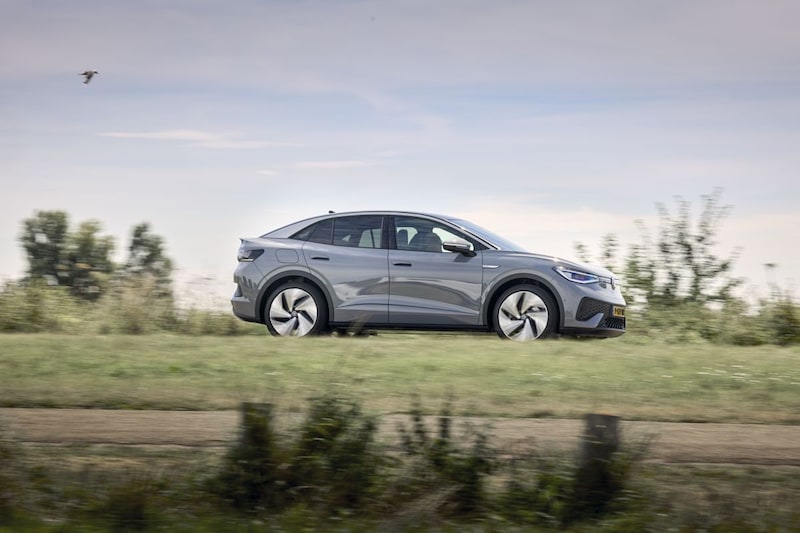
The third model that Volkswagen added to the electric ID range in Europe last year is the ID5. You can’t really call the car completely new, because it is in fact an ID4 with a somewhat smoother body. We test the streamlined SUV in the Pro version, with a single 204 hp electric motor between the rear wheels.
I know the ID3 and ID4, but I don’t really know the ID5 yet. Tell!
The Volkswagen ID5 is the elegant brother of the spacious ID4. The differences immediately catch the eye: the roof of the ID5 was pulled 1.8 centimeters lower and flows into the flat rear window in a smooth line. That looks nicer and smoother, but you pay €2,750 more for the ID5 than for the ID4. You could also say: you get less car for more money. As is the case with all coupe SUVs.
Rational arguments for this body shape are difficult to find. Well come on, we dug up one anyway: the ID5 has a better streamline than the ID4. Thanks to the sloping roofline, the coupé SUV scores a drag coefficient of 0.26 in the wind tunnel. The ID4, which is more angular in shape from the rear, contrasts with a drag coefficient of 0.28. Thanks to the better streamline, the ID5 uses the power supply slightly more economically and gets a little further on a full battery than the ID4.
Okay, but how does that lower roof work out for the ID5’s interior space?
It is certainly not easy in the Volkswagen ID5. In fact, in the front you will not notice anything from the sloping roof. That is different in the back seat. You clearly have less headroom than in the ID4, nevertheless there is more than enough air between your crown and the headliner. Even if the ID5 is equipped with a glass panoramic roof, like the test car, you sit in the back of the ID5 like a prince.
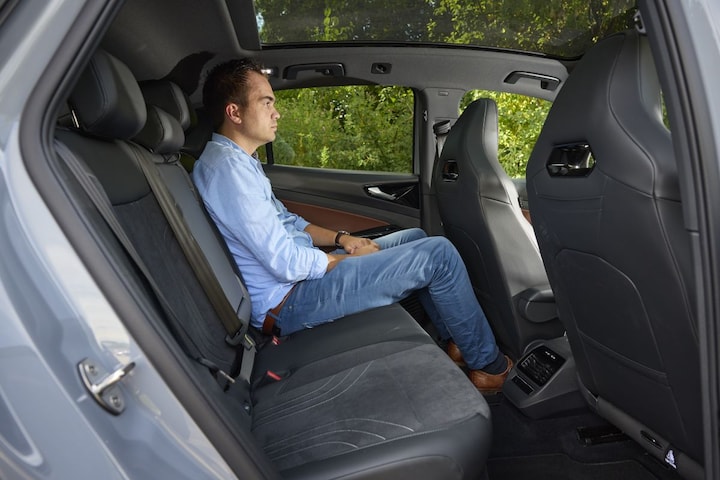
Given the sloping roofline, the headroom is very good.
The differences with the ID4 can also be seen in the trunk. In fact, because the ID5 is one and a half centimeters longer, there is 6 liters more in the back. If you lay the back seat flat, the ID4 has an advantage of 14 liters. A negligible difference. Despite the lower roofline, it is great that the ID5 has hardly lost any interior space. There is no ‘frunk’ in the front, even though space must be created for it due to the lack of an engine. The ID5 with rear-wheel drive is allowed to tow a 1,000 kilo braked trailer.
Does the Volkswagen ID5 look different from the ID4 inside?
Well, not really. The well-known ID style returns in the ID5 and that is not necessarily good news. The build quality seems fine, but a piece of artificial leather here and there cannot hide the fact that quite a lot of hard plastics have been used. The minimalist, uncluttered style looks modern, but at the same time has practical disadvantages. We’ve said it before, but the ID5 simply has too few buttons. The copies that do exist are usually of the digital and therefore extremely annoying kind. The buttons on the steering wheel and for the lighting often do not respond as you wish and vice versa, with all the annoyance that entails.
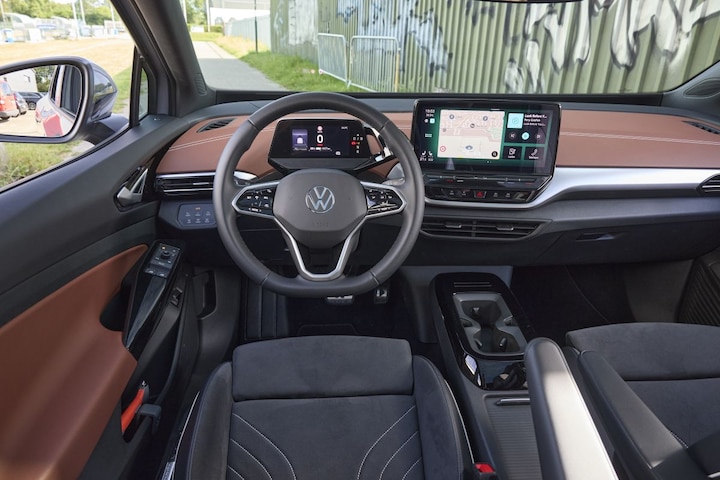
Clean design, the materials are not convincing
The central screen usually responds quickly, but not always. Moreover, you depend on it for too many things. Operating a certain function often requires several actions, which makes the whole thing unnecessarily complex. A nice gimmick of all ID models is the ‘ID.Light’ at the top of the dashboard. It consists of an LED bar that helps with navigation with all kinds of light signals, gives warnings or shows how full the battery is.
Does the technology of the Volkswagen ID5 make any difference?
No, because just like the ID3 and 4, the ID5 is also based on VW’s modular electric MEB platform. Which, for example, also includes the Cupra Born and Skoda Enyaq iV. And let’s especially the ID. Don’t forget Buzz as an MEB user, that nice electric retro van that has recently taken the Dutch roads by storm.
With the MEB platform, the electric motor is located in the base between the rear wheels. The different brands from the Volkswagen stable offer numerous power variants, with the ID5 the choice is limited to three versions. Our test car is the middle version, in which the driven rear wheels have an output of 204 hp.
The battery pack is integrated into the sandwich floor of the MEB platform, a method used by almost every new electric car – which is intended as an EV from the drawing board. For example, the battery cells take up little space and the car’s center of gravity can remain low.
The most powerful version of the ID5, the GTX, has an e-motor between the front wheels in addition to the electric motor in the rear. Handy for adding power and creating four-wheel drive. So that the car has enough traction to not let the high power go up in smoke.
Can the Volkswagen ID5 live up to its smooth design with smooth performance?
With its power of 204 hp, the electric motor must get a weight of 2,017 kilograms rolling. Because the maximum torque of 310 Nm is available from a standstill, the ID5 is also a fast car. From a standstill you are in 8.5 seconds on the hundred, an intermediate sprint from 80 to 120 km / h is done in 6.1 seconds.

No engine in the front, still no room for a frunk.
Does that drive a bit nice then, such an ID5?
The ID5 with 204 hp will never be a very fast car. The optional Sport package Plus of our test car does not change that. This package consists of progressive steering and adaptive shock absorbers that can be adjusted in fifteen (!) different positions. That amount is a gimmick, but it does make the ID5 more dynamic. Then you’ll be happy with the fine bucket seats that are part of the optional Interior Top-Sport package Plus. Because the engine is located in the rear, an impressively small turning circle is possible. Annoying drive reactions in the control are missing. However, one-pedal driving is not an option. When you have the ID5’s transmission in the regenerating B position, the car doesn’t come to a complete stop on its own.
Actually, I find it much more important how far the Volkswagen ID5 comes on a full battery.
We understand that, and the ID5 does not disappoint in that either. Volkswagen itself says that the ID5 with 204 hp will reach a distance of 533 kilometers from a battery charge from model year 2023. We tested the car on a sunny day at 20 degrees, conditions where the battery performs optimally. Yet we did not get further than a distance of 390 kilometers, a considerable difference with the WLTP specification. The 77 kWh battery (net) charges with a maximum power of 135 kW. That is slightly faster than, for example, the Nissan Ariya (with 130 kW) fast charging, but less quickly than the Volvo C40 (150 kW).
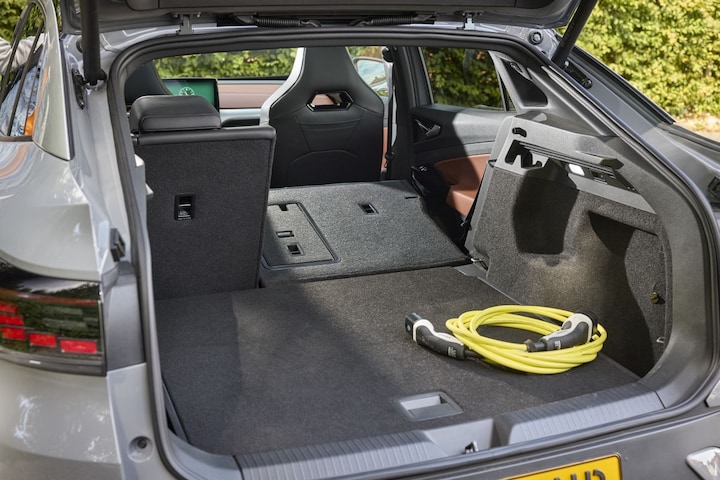
The luggage compartment is remarkably large
What other engine variants are there of the Volkswagen ID5?
In addition to the 204 hp version, there is also a less powerful rear-wheel drive version. This is powered by an electric motor that kicks it up to 174 hp. Less power does not automatically mean lower consumption and therefore a larger range: Volkswagen sticks to the same range of 533 kilometers.
If 204 hp is not enough, then there is the top model from the ID5 series, the GTX. Because this car is equipped with a second electric motor in the front, you automatically get 4Motion four-wheel drive. And with that, the maximum power of 299 hp can very easily be converted into fast sprints: the ID5 GTX accelerates to 100 in 6.3 seconds. Keep in mind that the GTX gets a slightly smaller range from the 77 kWh battery pack: 512 kilometers. But that should not spoil the fun.
What is standard on the ID5 and what do you have to pay extra for?
The Volkswagen ID5 is available in two basic versions: the Pro and the Pro Business. As standard you get LED headlights, 19-inch light metal, a multimedia system with a 25.4 cm screen and wireless smartphone integration, lane assist, adaptive cruise control, front and rear parking sensors and automatic air conditioning. The additional cost of the Pro Business is a modest €800, for which you get navigation, seat and steering wheel heating, air conditioning with separate temperature zones, keyless access, a reversing camera and a wireless phone charger – a ‘no brainer’ to choose the Pro Business.
However, there are also some important things missing from the ID5. Safety features such as blind spot sensors or pre-safe – where the car anticipates an imminent collision and, for example, tightens the seat belts – are part of (expensive) option packages. A heat pump and an adaptively damped chassis are also extras. When you include all additional costs in the base price (from a small €55,000 for the 204 hp Pro), you soon lift the Volkswagen ID5 over €60,000.
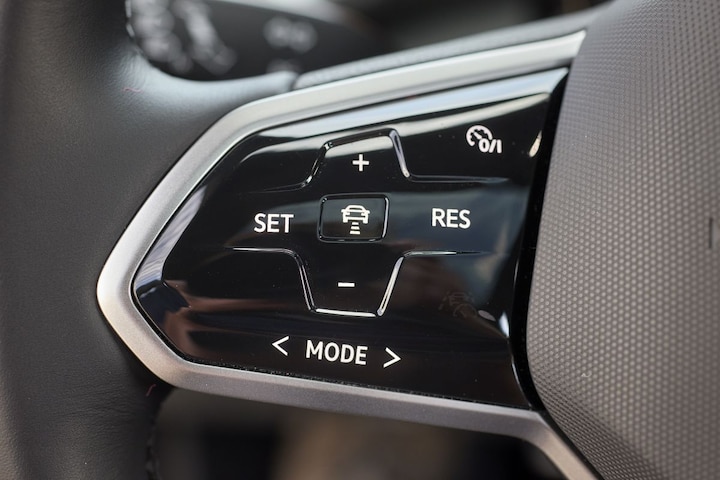
You sometimes operate the touch buttons on the steering wheel unintentionally.
The choice of AutoWeek Test Coordinator Marco Gorter
There is only one battery pack for the ID5, so you always have the 77 kWh version. Given the already not particularly efficient powertrain, we wouldn’t recommend the GTX version. In practice, it is hardly more fun to drive and you will get even less far. Given the limited additional cost, the Pro Business is the recommended version. We would in any case supplement it with a heat pump to maximize the range.
.
– Thanks for information from Autoweek.nl